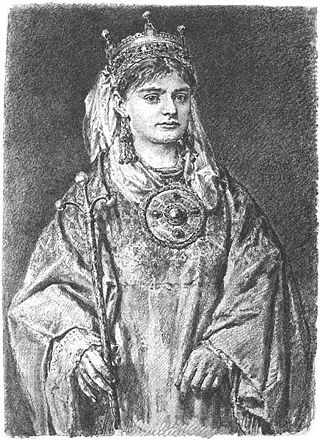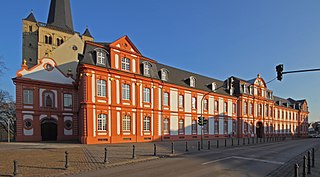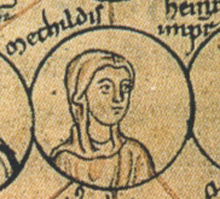
Richeza of Lotharingia was a member of the Ezzonen dynasty who became queen of Poland as the wife of Mieszko II Lambert. Her Polish marriage was arranged to strengthen the ties between Mieszko and her uncle Emperor Otto III. She returned to Germany following the deposition of her husband in 1031, either divorcing or separating from him. Upon the death of her brother Duke Otto II of Swabia and the consequent extinction of the male line of her family, Richeza became a nun, worked to preserve the Ezzonen heritage, and funded the restoration of the Abbey of Brauweiler. She has been beatified.
A count palatine, also count of the palace or palsgrave, was originally an official attached to a royal or imperial palace or household and later a nobleman of a rank above that of an ordinary count. The title originated in the late Roman Empire. In the Middle Ages especially and into modern times, it is associated with the Holy Roman Empire, especially Electoral Palatinate.
Ezzo, sometimes called Ehrenfried, a member of the Ezzonid dynasty, was Count Palatine of Lotharingia from 1015 until his death. As brother-in-law of Emperor Otto III, father of Queen Richeza of Poland and several other illustrious children, he was one of the most important figures of the Rhenish history of his time.

Landgrave was a noble title used in the Holy Roman Empire, and later on in its former territories. The German titles of Landgraf, Markgraf ("margrave"), and Pfalzgraf are roughly around the same rank, but below Herzog ("duke") and above the rank of a Graf ("count").

Brauweiler Abbey is a former Benedictine monastery located at Brauweiler, now in Pulheim near Cologne, North Rhine-Westphalia, in Germany. It is now used as a regional cultural center.
Otto II, a member of the Ezzonid dynasty, was Count Palatine of Lotharingia from 1034 until 1045 and Duke of Swabia from 1045 until his death.

Henry IV was the duke of Limburg and count of Berg from 1226 to his death. He was the son of Waleran III, count of Luxembourg and duke of Limburg, and Cunigunda, daughter of Frederick I, Duke of Lorraine.
Herman I, called Pusillus or the Slender, was the Count Palatine of Lotharingia, and of several counties along the Rhine, including Bonngau, Eifelgau, Mieblgau, Zülpichgau, Keldachgau, Alzey and Auelgau, from 945 until his death in 996.
Erenfried II was a Lotharingian nobleman, from the area of Rhineland area in what is now Germany.
Henry I, was Count Palatine of Lotharingia from 1045 until 1060. He was the son of Hezzelin I, Count in Zülpichgau, and a member of the Ezzonid dynasty. Historians have given several nicknames to Heinrich: Furiosus, because he murdered his wife, and Monachus, because he was confined into an abbey to treat his insanity.

Hermann II, Count Palatine of Lotharingia 1064–1085. He was count in the Ruhrgau and the Zulpichgau, as well as a count of Brabant.
Adolf I of Lotharingia, count of Keldachgau, Vogt of Deutz from 1008 until 1018, was the son of Hermann I "Pusillus", count palatine of Lotharingia. He left three sons:
Adolf II of Lotharingia (1002–1041) was count in Keldachgau and Vogt of Deutz, and was the son of Adolf I of Lotharingia, count in Keldachgau, Vogt of Deutz. He left two sons:

Herman II, a member of the Ezzonid dynasty, was Archbishop of Cologne from 1036 until his death.

The House of Limburg-Stirum, which adopted its name in the 12th century from the immediate county of Limburg an der Lenne in what is now Germany, is one of the oldest families in Europe. It is the eldest and only surviving branch of the House of Berg, which was among the most powerful dynasties in the region of the lower Rhine during the Middle Ages. Some historians link them to an even older dynasty, the Ezzonen, going back to the 9th century.

Matilda, Countess Palatine of Lotharingia, was a member of the Ottonian dynasty.
The House of Limburg was a dynasty which can be traced back in the male line as far as Henry, count of Limburg, whose mother Jutta was heiress of Frederick, Duke of Lower Lorraine in the House of Ardenne–Luxembourg. Henry was also related to the counts of Arlon. Waleran I was probably his father-in-law rather than his father.
Adelaide of Weimar-Orlamünde was the daughter of Otto I of Meissen and a member of the family of the counts of Weimar and Orlamünde. She married successively, Adalbert II of Ballenstedt, count palatine Herman II, and Henry of Laach.

The house of Limburg Hohenlimburg took its name in the 12th century from the county of Limburg on the river Lenne in today's Germany. After Diederick of Isenberg had claimed part of the former property of his father Frederik of Isenberg with the help of uncle Duke Hendrik of Limburg, he built the Hohenlimburg castle on the river Lenne. His youngest son Everhart succeeded him in the county at the end of the 13th century and is the ancestor of the family branch of the counts of Limburg Hohenlimburg and Broich. His eldest brother Johan (1247-1277), died at the age of thirty, left three children. The Counts of Limburg Hohenlimburg and Broich were not only a count by name (title), but actually ruled the county of Limburg-Lenne until the first quarter of the 16th century. The last count Johan (1464-1511) who had no descendants of his own. None of his only two male relatives, cousins Diederick and Adolf of Limburg, sons of his former godfather Johan of Limburg (1421-1472), had inheritance rights, as explained below. To prevent the family of his former wife Von Neuenahr from taking the county, Count Johan adopted his cousin Irmgard of Sayn at her marriage to Winrich of Daun. She and her husband inherited the county.










